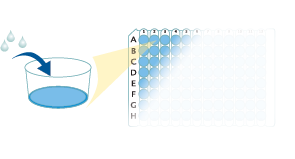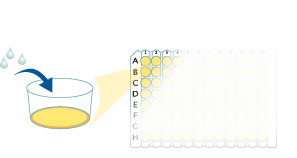Mouse Fas Ligand/TNFSF6 Quantikine ELISA Kit Summary
Product Summary
Precision
Cell Culture Supernates, Serum, EDTA Plasma
| Intra-Assay Precision | Inter-Assay Precision | |||||
|---|---|---|---|---|---|---|
| Sample | 1 | 2 | 3 | 1 | 2 | 3 |
| n | 20 | 20 | 20 | 20 | 20 | 20 |
| Mean (pg/mL) | 84 | 261 | 675 | 76 | 243 | 663 |
| Standard Deviation | 8.1 | 9 | 20 | 6.8 | 12 | 33 |
| CV% | 9.6 | 3.4 | 3 | 8.9 | 4.9 | 5 |
Recovery
The recovery of mouse Fas Ligand spiked to three levels throughout the range of the assay in various matrices was evaluated.
| Sample Type | Average % Recovery | Range % |
|---|---|---|
| Cell Culture Supernates (n=6) | 107 | 84-120 |
| EDTA Plasma (n=6) | 99 | 87-110 |
| Serum (n=6) | 98 | 86-111 |
Linearity
Scientific Data
Product Datasheets
Preparation and Storage
Background: Fas Ligand/TNFSF6
Fas Ligand (FasL), also known as CD178, CD95L, or TNFSF6, is a transmembrane protein homotrimer that binds to Fas/CD95 and triggers apoptosis in the Fas-expressing cell. Fas Ligand also binds the soluble decoy receptor DcR3. It is expressed on activated Th1 cells, CD8+ cytotoxic T cells, and NK cells. A soluble form can be released which remains trimeric and retains the ability to bind Fas. Fas Ligand-induced apoptosis plays a central role in the development of immune tolerance and the maintance of immune privileged sites. Tumor cells can evade immune surveillance by upregulating Fas Ligand to kill tumor infiltrating lymphocytes. In gld mice, a Fas Ligand point mutation is the cause of severe lymphoproliferation and systemic autoimmunity.
Assay Procedure
Refer to the product- Prepare all reagents, standard dilutions, and samples as directed in the product insert.
- Remove excess microplate strips from the plate frame, return them to the foil pouch containing the desiccant pack, and reseal.
- Add 50 µL of the appropriate Assay Diluent to each well.
- Add 50 µL of Standard, Control, or sample to each well. Cover with a plate sealer, and incubate at room temperature for 2 hours on a horizontal orbital microplate shaker.
- Aspirate each well and wash, repeating the process 4 times for a total of 5 washes.
- Add 100 µL of Conjugate to each well. Cover with a new plate sealer, and incubate at room temperature for 2 hours on the shaker.
- Aspirate and wash 5 times.
- Add 100 µL Substrate Solution to each well. Incubate at room temperature for 30 minutes on the benchtop. PROTECT FROM LIGHT.
- Add 100 µL of Stop Solution to each well. Read at 450 nm within 30 minutes. Set wavelength correction to 540 nm or 570 nm.





Citations for Mouse Fas Ligand/TNFSF6 Quantikine ELISA Kit
R&D Systems personnel manually curate a database that contains references using R&D Systems products. The data collected includes not only links to publications in PubMed, but also provides information about sample types, species, and experimental conditions.
13
Citations: Showing 1 - 10
Filter your results:
Filter by:
-
Lung Injury Combined with Loss of Regulatory T Cells Leads to De Novo Lung-Restricted Autoimmunity
J Immunol, 2016-05-18;0(0):.
Species: Mouse
Sample Types: BALF
-
Hematopoietic Fas deficiency does not affect experimental atherosclerotic lesion formation despite inducing a proatherogenic state.
Authors: de Claro RA, Zhu X, Tang J, Morgan-Stevenson V, Schwartz BR, Iwata A, Liles WC, Raines EW, Harlan JM
Am. J. Pathol., 2011-05-06;178(6):2931-7.
Species: Mouse
Sample Types: Plasma
-
TLR4 through IFN-beta promotes low molecular mass hyaluronan-induced neutrophil apoptosis.
Authors: Leu SW, Shi L, Xu C, Zhao Y, Liu B, Li Y, Shiedlin A, Xiang C, Shen H, Quinn DA, Hales CA, Zhao H
J. Immunol., 2010-11-22;186(1):556-62.
Species: Mouse
Sample Types: BALF
-
Ectodomain shedding of EGFR ligands and TNFR1 dictates hepatocyte apoptosis during fulminant hepatitis in mice.
Authors: Murthy A, Defamie V, Smookler DS
J. Clin. Invest., 2010-07-12;120(8):2731-44.
Species: Mouse
Sample Types: Serum
-
Critical roles of inflammation and apoptosis in improved survival in a model of hyperoxia-induced acute lung injury in Pneumocystis murina-infected mice.
Authors: Beck JM, Preston AM, Wilcoxen SE, Morris SB, Sturrock A, Paine R
Infect. Immun., 2009-01-05;77(3):1053-60.
Species: Mouse
Sample Types: Tissue Homogenates
-
Mechanical ventilation enhances lung inflammation and caspase activity in a model of mouse pneumovirus infection.
Authors: Bem RA, van Woensel JB, Bos AP, Koski A, Farnand AW, Domachowske JB, Rosenberg HF, Martin TR, Matute-Bello G
Am. J. Physiol. Lung Cell Mol. Physiol., 2008-11-07;296(1):L46-56.
Species: Mouse
Sample Types: Tissue Homogenates
-
Ozone inhalation induces exacerbation of eosinophilic airway inflammation and hyperresponsiveness in allergen-sensitized mice.
Authors: Kierstein S, Krytska K, Sharma S, Amrani Y, Salmon M, Panettieri RA, Zangrilli J, Haczku A
Allergy, 2008-04-01;63(4):438-46.
Species: Mouse
Sample Types: BALF
-
Tissue inhibitor of metalloproteinases-3 facilitates Fas-mediated neuronal cell death following mild ischemia.
Authors: Wetzel M, Li L, Harms KM, Roitbak T, Ventura PB, Rosenberg GA, Khokha R, Cunningham LA
Cell Death Differ., 2007-10-26;15(1):143-51.
Species: Mouse
Sample Types: Cell Culture Supernates
-
The Fas/Fas ligand system inhibits differentiation of murine osteoblasts but has a limited role in osteoblast and osteoclast apoptosis.
Authors: Kovacic N, Lukic IK, Grcevic D, Katavic V, Croucher P, Marusic A
J. Immunol., 2007-03-15;178(6):3379-89.
Species: Mouse
Sample Types: Cell Lysates
-
Targeted cardiac expression of soluble Fas prevents the development of heart failure in mice with cardiac-specific expression of MCP-1.
Authors: Niu J, Azfer A, Deucher MF, Goldschmidt-Clermont PJ, Kolattukudy PE
J. Mol. Cell. Cardiol., 2006-05-05;40(6):810-20.
Species: Mouse
Sample Types: Plasma
-
Suppression of graft coronary artery disease by a brief treatment with a selective epsilonPKC activator and a deltaPKC inhibitor in murine cardiac allografts.
Authors: Tanaka M, Terry RD, Mokhtari GK, Inagaki K, Koyanagi T, Kofidis T, Mochly-Rosen D, Robbins RC
Circulation, 2004-09-14;110(11):II194-9.
Species: Mouse
Sample Types: Tissue Homogenates
-
Cardiomyocyte-specific Bcl-2 overexpression attenuates ischemia-reperfusion injury, immune response during acute rejection, and graft coronary artery disease.
Authors: Tanaka M, Nakae S, Terry RD, Mokhtari GK, Gunawan F, Balsam LB, Kaneda H, Kofidis T, Tsao PS, Robbins RC
Blood, 2004-07-27;104(12):3789-96.
Species: Mouse
Sample Types: Tissue Homogenates
-
T cell-specific ablation of Fas leads to Fas ligand-mediated lymphocyte depletion and inflammatory pulmonary fibrosis.
Authors: Hao Z, Hampel B, Yagita H, Rajewsky K
J. Exp. Med., 2004-05-17;199(10):1355-65.
Species: Mouse
Sample Types: Serum
FAQs
No product specific FAQs exist for this product, however you may
View all ELISA FAQsReviews for Mouse Fas Ligand/TNFSF6 Quantikine ELISA Kit
There are currently no reviews for this product. Be the first to review Mouse Fas Ligand/TNFSF6 Quantikine ELISA Kit and earn rewards!
Have you used Mouse Fas Ligand/TNFSF6 Quantikine ELISA Kit?
Submit a review and receive an Amazon gift card.
$25/€18/£15/$25CAN/¥75 Yuan/¥2500 Yen for a review with an image
$10/€7/£6/$10 CAD/¥70 Yuan/¥1110 Yen for a review without an image








